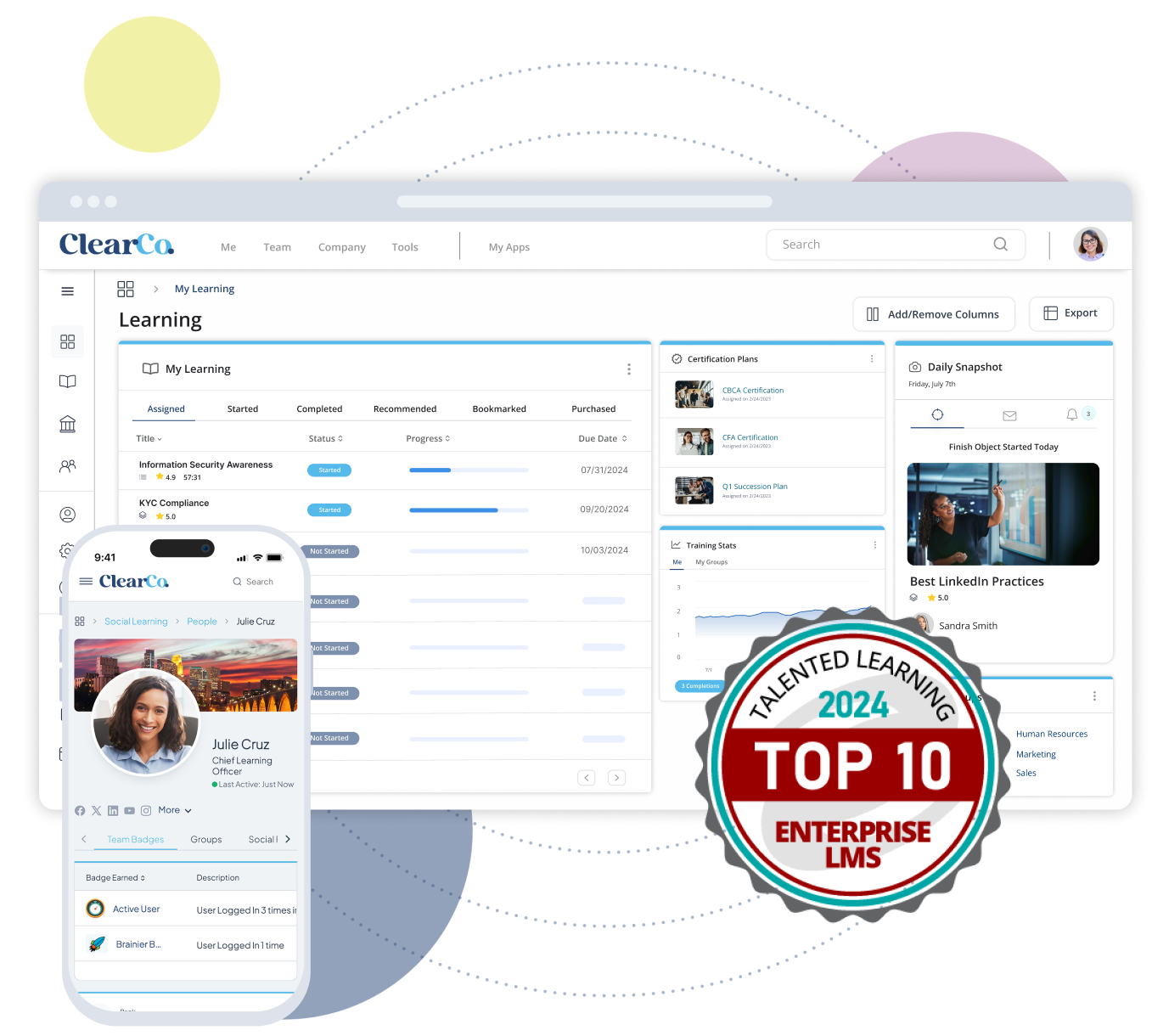Investing in learning and development (L&D) pays off — literally. Companies with in-depth training programs are 17% more productive and 21% more profitable than those without. That’s because a well-trained workforce is more productive, creative, and engaged. When you equip your employees with the skills they need to excel, they’re better problem-solvers and quicker to adapt to change.
But building an effective L&D strategy isn’t without obstacles. From proving ROI to engaging learners in a digital-first world, L&D teams face a growing list of hurdles. On top of that, keeping training content relevant and personalized is no small feat, especially if your company is large or growing.
Tackling these challenges takes both smart planning and creative solutions. We’ll dive into some of the biggest challenges in L&D today and give you some strategies to overcome them so your business can thrive.
1. Talent Shortages & Skills Gaps
One of the most pressing challenges in learning and development today is the shortage of talent. The shortage is spurred by widening skills gaps, which 63% of companies say are a major barrier in recruiting and will be until 2030. These gaps impact hiring most immediately, but they have a ripple effect across the business. Productivity takes a hit, innovation stalls, and employees left to pick up the slack often face burnout.
Over time, these challenges can erode efficiency and make it harder for your company to stay competitive.
Overcoming the Obstacle
Fortunately, you can address this challenge head-on. Upskilling and reskilling your current team is one of the most effective strategies, not only to close skills gaps but also to keep employees engaged and motivated. When you create learning programs that meet your team where they are, you can prepare them to take on new roles and unfamiliar challenges.
On the hiring side, thinking outside the box can make a big difference. Hiring platforms with artificial intelligence (AI) capabilities can help uncover hidden talent by identifying transferable skills. Offering flexible work options makes your company more attractive to top candidates.
Addressing talent shortages takes effort, but the reward is a stronger, more adaptable workforce ready to take on whatever comes next.
2. Aligning Learning Initiatives With Strategic Business Goals
L&D professionals know the struggle of finding development opportunities that meet employees’ needs and drive better business outcomes. Just 43% of companies say their learning initiatives are well aligned with business goals. Without this alignment, it’s difficult to point to the measurable results of training programs, and harder for employees and leadership to see its value.
Overcoming the Obstacle
You can avoid this obstacle by starting with the end in mind — understanding what your L&D programs are meant to achieve. Maybe your org needs to increase customer retention or reduce ticket resolution time. Regardless of your specific goals, every learning initiative should be tied to a clear, measurable goal. For example, if the goal is to boost sales win rates, training should focus on skills like active listening and needs discovery, with role-playing exercises that mimic real-world scenarios.
Collaboration is also critical. Partner with senior leaders to co-create training programs to ensure learning initiatives align with priorities across the company. And don’t forget to measure what matters — track both leading indicators like skill proficiency and lagging indicators like revenue growth or customer satisfaction. This data helps prove the value of your learning strategy and helps refine it over time.
When learning initiatives directly drive business outcomes, they graduate from being a nice perk to strategic drivers of success.
3. Proving the ROI of Learning & Development Programs
Did you know that 57% of software buyers expect to see returns on investment within three months? Leadership expects to see big expenses pay off, but only 4% of companies are tracking L&D ROI. When they’re spending an average of $1,400 per employee each year, tracking traditional learning and development KPIs doesn’t tell the whole story.
Overcoming the Obstacle
To really prove L&D’s value, start every program by identifying the key business outcomes you’re aiming to impact, whether that’s reducing time-to-competence for new hires or increasing sales win rates. Track a mix of leading indicators (like skill proficiency) and lagging measures (e.g., retention or revenue growth) to show direct, real-world results.
AI-powered learning management systems (LMS) make this possible without manual guesswork. Modern learning platforms automate tracking, personalize metrics for every learner, and connect skill-building to performance using dashboards and predictive analytics. These tools can even identify skills gaps in real time, helping you adjust programs as needs shift so every training initiative is tied back to measurable ROI.
If you want actionable insights, pilot programs and A/B testing are essential — and these systems make them easier than ever to execute and evaluate. When you can tie learning to business outcomes (and show it on a dashboard), you make a much stronger case for investing in your people’s long-term growth.
4. Engaging Learners in a Distracted World
Learning experiences that capture employees’ attention are harder than ever to execute. LinkedIn research shows that the number of employees who say their managers encouraged them to spend time on L&D declined by 6% in the past year. There was also a 5% decrease in those who said their managers challenged them to learn a new skill.
There’s clearly an immediate need for L&D initiatives that cut through the noise. Engagement hinges on making learning active and relevant, not passive and unrelated. Interactive formats and social collaboration bring learning to life and help it stick.
Overcoming the Obstacle
Build interactive learning experiences — think peer-led discussions, simulations, and gamified courses. Short, focused content and opportunities for real-time collaboration help employees connect with material and one another. Microlearning modules also help avoid cognitive overload and keep learners coming back. Combine this with AI-powered platforms that personalize content, ensuring your employees see value in every lesson.
5. Delivering Personalized Learning at Scale
Personalization is what employees have come to expect — and it drives real results. Skills-based talent development makes organizations 63% more likely to achieve their goals than those using a one-size-fits-all approach. But what if you need to deliver custom learning paths to thousands of employees?
Overcoming the Obstacle
Turn to AI-driven platforms that recommend tailored content based on role and skill gaps. Adaptive assessments and data insights help you deliver the right learning to the right person at the right time — without manual effort.
6. Budget & Time Constraints
You might have big dreams for your L&D program, but what you picture doesn’t align with your budget or bandwidth. In leaner times, L&D is often one of the first areas where budget is cut.
Overcoming the Obstacle
Prioritize high-impact, low-cost initiatives. Pilot small programs to prove value, use internal subject-matter experts, and lean on existing tools for delivery. Focus on measurable business outcomes so leadership sees the return and wants to sustain the investment.
7. Integrating & Optimizing Learning Technology
Learning platforms are essential, but adoption remains a stumbling block. About 39% of change programs fail, often because they’re difficult to use and there’s low user buy-in.
Overcoming the Obstacle
Choose learning solutions that are intuitive and offer robust support. Take your time with implementation and onboarding, and seek continuous feedback from users to refine workflows and features. When platforms work seamlessly, everyone benefits.
8. Keeping Learning Content Relevant & Up-to-Date
Stale content can lose credibility fast. At the same time, keeping L&D programs up to date is more challenging than ever, thanks to shifting industry standards and rapid tech advancement.
Overcoming the Obstacle
Set regular content review cycles and enlist subject-matter experts for ongoing updates. Use analytics to spot outdated or underperforming content, and give employees an avenue to suggest new learning modules based on what they need. Access to learning content marketplaces can also help quickly scale relevant, up-to-date training options without having to build everything from scratch.
9. Measuring Beyond Completion Rates
You don’t know if you’re executing successful learning and development strategies unless you look at more than just course completion rates. L&D leaders are looking at more advanced analytics to see impact, tracking knowledge retention, behavioral impact, and business outcomes.
Overcoming the Obstacle
Gain clarity around L&D’s business impact effortlessly with AI-powered learning software. Modern LMSs make it easy to track before-and-after assessments, peer feedback, and on-the-job application of new skills. Use analytics dashboards to capture ongoing skill growth and connect training investments directly to productivity, engagement, and retention.
Overcome L&D Challenges With ClearCompany Learning
Learning that sticks changes business outcomes. That’s why building a future-ready workforce means tackling L&D challenges with smarter tools and data-driven insights.
ClearCompany’s AI-powered Learning Management System delivers personalized content, real-time analytics, and the agility your organization needs to close skill gaps fast and measure progress confidently.
Ready to see measurable growth from your learning programs? Schedule your demo today and lead the change.



